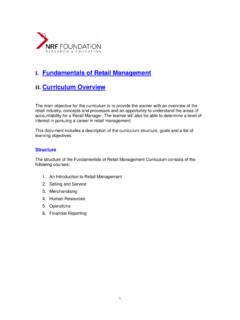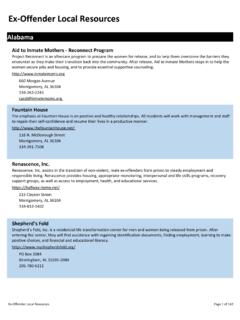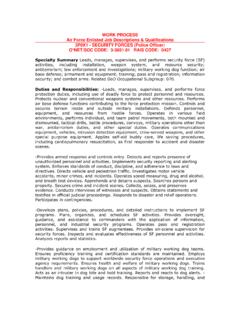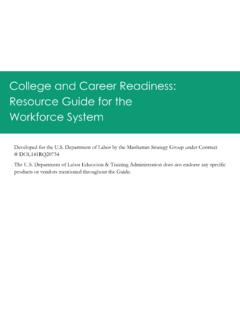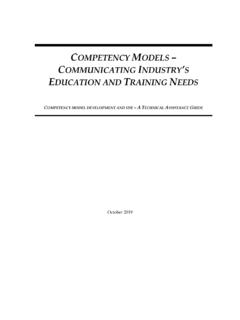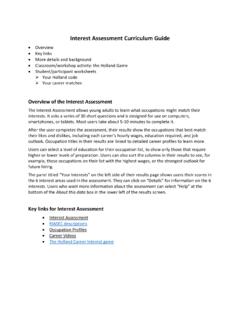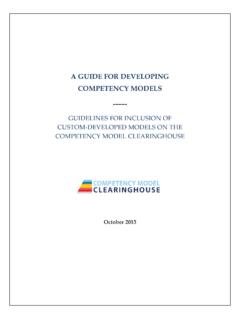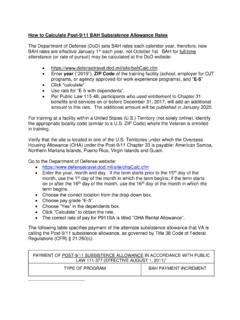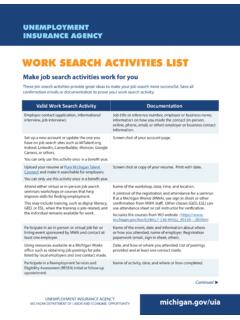Transcription of AFSC 3S2X1 Education and Training - CareerOneStop
1 DEPARTMENT OF THE AIR FORCECFETP 3S2X1 Headquarters US Air ForceParts I and IIWashington, DC 20330-1030 November 2000 AFSC 3S2X1 Education and TrainingCAREER FIELD EDUCATIONAND Training PLAN1 CAREER FIELD Education AND Training PLANEDUCATION AND Training SPECIALTYAFSC 3S2X1 Table of ContentsPART IPreface _____ 3 Abbreviations/Terms Explained _____ 4 Section A, General Information _____ 7 PurposeUsesCoordination and ApprovalSection B, Career Progression and Information _____ 8 Specialty DescriptionSkill/Career ProgressionApprentice Level (3)Journeyman Level (5)Craftsman Level (7)Superintendent Level (9) Training DecisionsCommunity College of the Air ForceActive Duty and Reserve Career PathSection C, Skill Level Training Requirements _____ 13 PurposeSpecialty Qualification RequirementsApprentice Level (3)Journeyman Level (5)Craftsman Level (7)Superintendent Level (9)Section D, Resource Constraints _____ 16 Section E, Transitional Training Guide_____ 172 PART IISection A, Course Objective List _____ 18 Section B, Support Materials_____ 18 Section C, Training Course Index _____ 18 Section D, MAJCOM Unique Requirements _____ 19 Section E, Specialty Training Standard_____ 19 Supersedes: CFETP 3S2X1 dated November 1998 Prepared by.
2 82 TRSS/TTF (Ms. Susan Awtry)Approved by: HQ USAF/DPDTT (CMSgt Akeel Omari)Certified by HQ USAF/DPDT, (Colonel David Ferguson)3 Education AND Training SPECIALTYAFSC 3S2X1 CAREER FIELD Education AND Training PLANPart IPreface1. This Career Field Education and Training Plan (CFETP) is a comprehensive document thatidentifies Education / Training requirements, support resources, and minimum core taskrequirements for this specialty. The CFETP will provide personnel a clear career path and willestablish formality in all aspects of career field Training . NOTE: When applicable, civiliansoccupying associate positions may use the CFETP Part II to support duty position The CFETP consists of two parts; both parts of the plan are used to plan, manage, and controltraining within the career Part I provides information necessary for overall management of the specialty.
3 Section Aexplains how everyone will use the plan; Section B identifies career field progressioninformation, duties and responsibilities, Training strategies, and career field path; Section Cassociates each level with specialty qualifications (knowledge, Education , Training , and other);Section D indicates resource constraints. Some examples are funds, manpower, equipment, CFETP Part II includes the following: Section A, the Course Objective List; Section B,Support Material; Section C, the Training Course Index; and Section D, the list of MAJCOMU nique Requirements. Section E, identifies the Specialty Training Standard (STS), whichincludes duties, tasks, technical references to support Training , Air Education and TrainingCommand (AETC) conducted Training , core tasks, wartime tasks, and correspondence Using guidance provided in the CFETP will ensure AFSC 3S2X1 personnel receive trainingat the appropriate point in their career.
4 At the unit level, supervisors and trainers will use CFETPPart II to identify, plan, and conduct Training commensurate with the overall goals of this EXPLAINEDA dvanced Distributed Learning (ADL) ADL is an evolution of distributive learning[distance learning] that emphasizes collaboration on standards-based versions of reusableobjects, networks, and learning management systems, yet may include some legacy methods Training (AT) A formal course d for a technical or supervisor level Air ForceSpecialty (AFS). Training is for selected career airman in the advanced technology of the is normally restricted to senior NCOs. Graduates are not awarded a new Force Career Field Manager (AFCFM) An individual charged with the responsibility foroverseeing all Training and career field management for an Air Force specialty or group Force Job Qualification Standard (AFJQS) A comprehensive task list common to allpersons serving in the duty position, which describes a particular job type or duty Force Specialty A group of positions (with the same title and code) that require Field Education and Training Plan (CFETP) A comprehensive core trainingdocument that identifies.
5 Education and Training requirements Training support resources Minimum core task requirements for a specialtyThe CFETP gives personnel a clear career path and instills formality in career field Based Training (CBT) The use of computers to aid in the delivery andmanagement of Task A performance statement identified by the AFCFM as a minimum qualificationrequirement within an AFSC. Core tasks may be specified for a particular skill level, dutyposition, or in general across the AFS. Guidance for using core tasks can be found in theapplicable CFETP Objective List (COL) A comprehensive list derived from an initial/advanced skillsCourse Training Standard, identifying the tasks, knowledge requirements, and performancecapability required to achieve a 3-/5-/7-skill level in an AFS.
6 Supervisors use the COL to assistin conducting graduate evaluations in accordance with AFI 36-2201, Developing, Managing andConducting Military Training Learning (DL) Includes video teleseminar (VTS), video teletraining (VTT), CareerDevelopment Courses (CDCs) and computer based Training (CBT). Formal courses that atraining wing or a contractor develops for export to a field location (in place of resident Training )for trainees to complete without on-site support of the formal school Position The tasks assigned to an individual for the position currently held. Theseinclude as a minimum all core tasks and tasks assigned by the Manager (FM) Individual charged with responsibility for overseeing Training andcareer field management activities within a respective MAJCOM.
7 These individualsassist/advise the AFCFM in decisions regarding the associated career field and provide input at aUtilization and Training workshop (U&TW).Initial Skills Training A formal school course that results in an AFSC 3-skill level Survey Report (OSR) A detailed report showing the results of an occupationalsurvey of tasks performed within a particular Training (OJT) Hands-on, over-the-shoulder Training that a duty location usesto certify personnel in both upgrade (skill-level award) and job qualification (positioncertification) Training (QT) Hands-on performance Training that personnel design to qualifyan airman in a specific position.
8 This Training occurs both during and after upgrade Training tomaintain up-to-date Sites Typical organizational units having similar missions, weapon systems orequipment, or a set of jobs, used as a basis for estimating average Training capacities and costswithin the Training Impact Decision System (TIDES).Resource Constraints Resource deficiencies, such as money, facilities, time, manpower, andequipment that preclude desired Training from being Training The total Training process used to qualify airmen in their Training Standard (STS) An air Force publication that describes skills andknowledge that an airman in a particular Air Force specialty needs on the job.
9 It further serves asa contract between AETC and the AFS. The STS matches the job performance requirements foran AFS ) with the applicable course Training An exact value, a physical entity, or an abstract concept that the appropriateauthority custom, or common consent sets up and defines to serve as a reference, model, or rulein measuring quantities or qualities, developing practices or procedures, or evaluating results. Afixed quantity or Force All collective Air Force components (active, reserve, guard, and civilian elements)of the United States Air Capability The ability of an organization to provide Training . Authorities considerthe availability of equipment, qualified trainers, study reference materials, and so on indetermining a Training Capacity The capability of a Training setting to provide Training on specifiedrequirements, based on the availability of Impact Decision System (TIDES) Decision support system to help information andtraining communities balance a specialty s Training needs versus resources and requirements tooptimize career field Planning Team (TPT) Comprised of subject matter experts (SMEs) who are moreintimately involved in Training development.
10 The range of issues surpasses those covered duringthe Utilization and Training workshop (U&TW). Training Requirements Analysis A detailed analysis of tasks for a particular AFS to beincluded in the Training decision Training Special or regular onsite Training that Training Detachments (TDs) or MobileTraining Teams (MTTs) conduct. These TDs and MTTs consist of AETC instructors thatauthorities have temporarily assigned to conduct onsite Training at operational Training Job Site Training (JST) is formal Training developed by a Training wing(TRW) or a TRW contractor to be exported to a field location and designed to be learned withoutthe on-site support of the formal school instructor.
